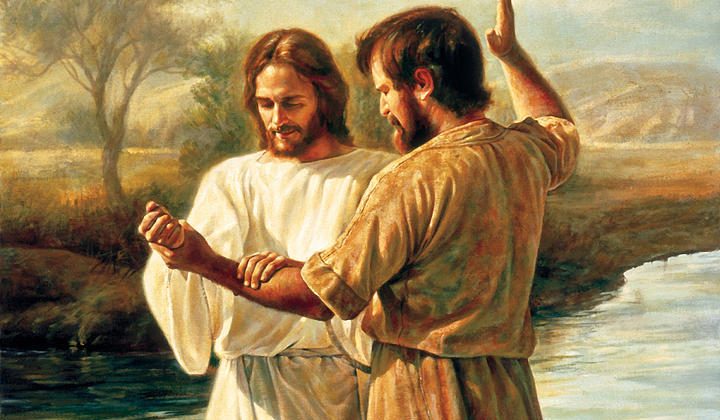
Our Lord’s baptism, though it formed the beginning of His public ministry when He first stepped upon the world stage (and thus was the first thing narrated in Mark’s Gospel, which focussed upon that verifiable and public ministry) was not the beginning of His descent among us, nor the end of it. Rather, His baptism was the middle movement of that descent, the second in a dramatic play of three kenotic acts. St. Paul writes in his letter to the Philippians how the eternal Word, though being in the form of God, did not consider that such divine privilege was something to cling to, but emptied Himself (Greek κενοω/ kenoo), exchanging the form of God for the form of a slave, all the while remaining entirely divine.
This kenosis or self-emptying began at the Annunciation, when He united human nature to Himself in the womb of a young Jewish teenager. It continued at Christmas time (the public fulfillment of the Annunciation), when the eternal Word took His first human breath and was carried from the womb of the Virgin to share our world and to live among us. That was the first of the three dramatic acts. The Most High, the Logos who dwelt beyond time and space in the bosom of the Father, surrounded by the adoration of the cherubim and the fiery devotion of the seraphim, plunged down into the mire and muck that was planet earth. Regardless of what the hymn Away in a Manger tells us, the baby Jesus almost certainly “crying did make”, startling and crying at sudden loud sounds, like all babies do. In this first of three acts, the Infinite God became small enough to be laid within the confines of a manger, an animal’s feeding trough. The source of all wisdom had to learn His ABC’s; the fountain of all might had to learn control of His bowels. If all this seems impiously scandalous, it is. It is also a measure of how much God loves us, and to what extremes that love was willing to go to win us back to Himself.
The darkened Nativity cave gave way to the sunlit waters of the Jordan, and the feast of the Christmas to the feast of Theophany. In Christ’s thirtieth year, He came to set His seal upon the ministry of His kinsman John, to whom the Word of the Lord had come in fifteenth year of Tiberius Caesar. When Christ took His first kenotic step into our world, He was greeted by the wonder of the shepherds and the gifts of the Magi. At this second step, He found Himself amid a more unsavoury crowd: prostitutes and tax-collectors, and sinners, people whom your parents took great care to keep away from you. With the same humility which once propelled Him into our midst, Christ stood silently among them, awaiting a sinner’s baptism at the hand of John. He did not disdain their company, nor raise His voice to assure them that He was not there because He was in any way like them, but only “to fulfill all righteousness”. Like a lamb before His shearers is dumb, so He opened not His mouth to protest His innocence or preserve His dignity—nor was this the last time He would keep such silence and manifest such an unappreciated humility. John of course, His kinsman since childhood, knew of the incongruity of Jesus getting soaked with the sinners, and he offered some word of quiet protest. But the exchange between Master and Servant was private enough, and onlookers saw only Jesus of Nazareth joining their movement and taking His place among sinners, waiting like them for the mercy of God. The journey to the Jordan did not end at the river’s edge, but at the Cross. The descent into the cold Judean waters was but the prelude to another colder and more terrible baptism (Luke 12:50), an immersion into suffering and death. The second kenotic act would culminate in the third and final one. The plunge into our existence took the Lord ever deeper down, until He reached the nadir of our existence.
In that final descent to the bottom, the Master would again find incongruous treatment at the hands of His servants when He was mocked and slapped at His trial, and we would again find the Sinless One in the midst of sinners, when He was crucified between two thieves. In this fact act of the divine drama our Lord concluded His long and continuing kenosis, for there was no further depth to which He could sink. He endured arrest, mocking, torture, death and burial, and dwelt among the shades of Sheol. In each of these three acts of self-abasement and humility, Christ had plunged to subterranean depths—born in a cavern under the earth, immersed under the waters of the river, and finally ending in Hades, the underground land of the dead.
What does this mean for us? St. Paul, who spoke of Christ’s kenosis, makes it clear enough: we must let the attitude of humility that motivated such divine self-emptying be in us as well. If the King endured such fearful things, we His servants must learn not to strut or complain or demand our rights.
When Christ descended into the waters of the Jordan He drowned our pride in that river as well. Throughout His life Jesus demonstrated the towering humility of God, a divine drama laying waste our delusional self-importance in three acts. His kenosis led at length to His exaltation to the right hand of God. If we would follow Him home, we too must embrace His humility.
